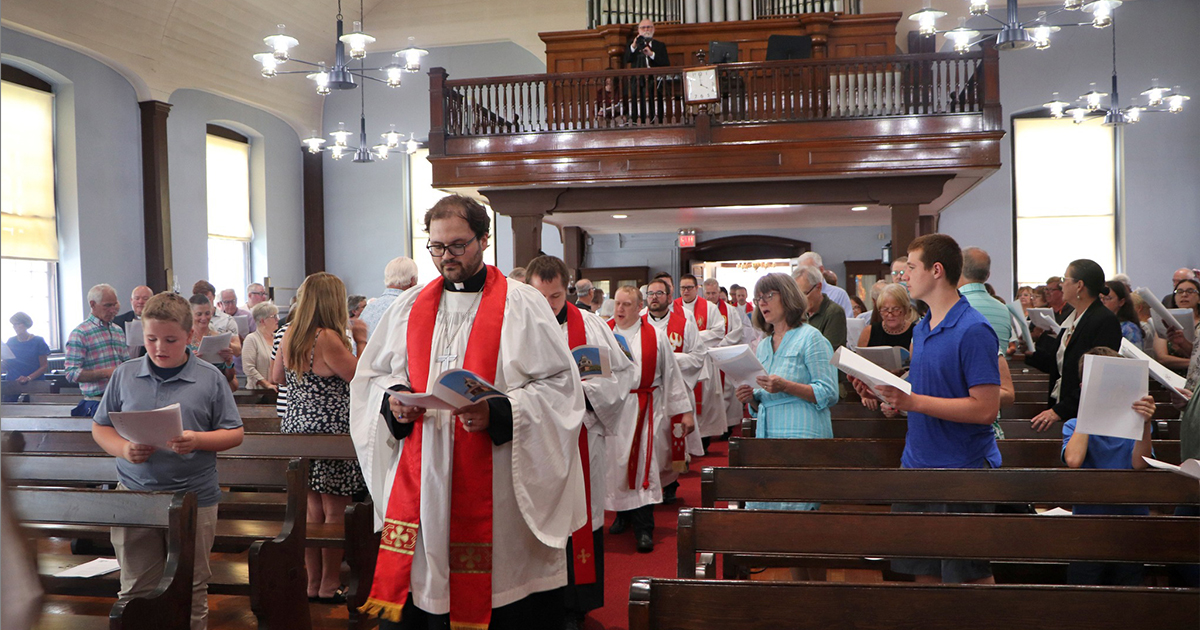
By Kristin Straeuli
Just northwest of Pittsburgh lies the town of Ambridge, Penn. Known more recently for its namesake, The American Bridge Company, the town’s main claim to fame and history goes back much further — 200 years back — when an immigrant German religious group known as the Harmony Society (with members known as Harmonists) founded the village of Ökonomie (Economy) in 1824.
The church that the Harmonists and their leader, Georg Rapp, built between 1828 and 1831 as the focal point of their communal life still stands today. On Sunday, Aug. 18, St. John’s Lutheran Church of Ambridge, the congregation that has called that nearly 200-year-old church its home since 1912, was received into fellowship with The Lutheran Church—Missouri Synod (LCMS).
Rapp and his pietistic, millennialist sect had already departed theologically from the Lutheran church in Germany before coming to the United States in 1803. They strove to form a utopian society of communal living as they waited for the return of Christ. Economy was the Harmony Society’s third and final religious commune after establishing Harmony, Penn., and then Harmony, Ind. (later renamed New Harmony), before returning to the Pittsburgh area. They were known for their industriousness and vast business endeavors in a wide array of trades — cabinet making, wine pressing, and even manufacturing silk and velvet, to name a few — and were an influential economic force in the area.
When, for various reasons (including their advocated practice of celibacy), the Harmony Society dwindled and then disintegrated at the turn of the 20th century, the church that stood in the center of their settlement was among the imprint they left behind. Soon after, the German-Lutheran congregation, St. John’s Lutheran Church of Ambridge (est. 1907), purchased the church building and has led a full congregational life there since.
At the proper time
While St. John’s, Ambridge, has long been unwavering in their commitment to Scripture and the Lutheran Confessions, their long-time affiliation with the American Lutheran Church came to an end in 1988, when they declined to be a part of the merger that formed the Evangelical Lutheran Church in America. Instead, they remained an independent congregation, up until a recent dual-affiliation with the Lutheran Congregations in Mission for Christ and the North American Lutheran Church. In fact, they came very close to joining the LCMS in the 1980s. At that time, a young LCMS pastor serving his first call at Mount Olive Lutheran Church in Beaver Falls, Penn. (less than half an hour away), was the circuit visitor the LCMS Eastern District had appointed to dialogue with St. John’s.
Fast-forward 30-some years and that circuit visitor, the Rev. John Pingel, is now the LCMS Eastern District president. Last April, he and his assistant, Bruce Sutherland, were on their way to meetings being held at that same former parish when they received a call from St. John’s, Ambridge: “Will you come and see us? We want to join the LCMS.”
Fidelity to sound doctrine
The process to enter into membership with the LCMS went smoothly and quickly thereafter. The congregation submitted its constitution to the district for review, and also needed to hold two congregational votes to join, 30 days apart. Both votes were unanimous. “The transition was easy, as our constitution mirrored almost exactly a constitution from an LCMS church,” recalled Bob Ferry, long-time member and chairman of Trustees at St. John’s. And they weren’t the only ones being examined for their theological stance: “They questioned us, rather intently,” Pingel said of the congregation’s commitment to sound doctrine and desire to enter into this new fellowship faithfully. “I’ve never met a bunch of people so thrilled to be Missouri Synod,” remarked Pingel.
Walking together
Since that conversation in April, the saints of St. John’s have not missed an opportunity to connect with their brothers and sisters in the LCMS. Sutherland said, “They asked us about ‘synod,’ and we talked about that as ‘walking together.’ They took that and just ran with it.” Prior to even being an official member of the Synod, they were “fully engaging” with their future sister congregations in the area, getting together for Bible studies, church picnics and to socialize. The LCMS congregations in the Pittsburgh area generously donated 200 Lutheran Service Books (LSB) to the Ambridge congregation, and even had to be asked to stop giving when the church had enough!
“We were not familiar with ‘walking together.’ We thought we were isolated. It actually feels like we’re coming home,” Ferry said of joining the LCMS. In fact, the most noted part of the transition wasn’t theology or practice, as that was already aligned, but rather the familiarity and fellowship they now have with the other LCMS congregations. “And people are so excited for the fellowship.”
Dwelling in unity
The day of celebration, Sunday, Aug. 18, began with an organ recital by Jonathan Hoyt, kantor and organist of First Trinity Evangelical-Lutheran Church in Pittsburgh, followed by a church service with many pastors from the neighboring LCMS congregations of the Eastern, English and SELC districts vested in attendance. In his sermon, Pingel promised, “You don’t have to ever worry about what you are going to hear out of the mouth of one of our pastors. You will always, and inevitably, hear the Gospel of a crucified and risen Christ proclaimed.”
In the rite of reception into membership, Pingel greeted the new LCMS congregation: “With thanksgiving to God and rejoicing in the fellowship that binds us together in the faith, I welcome you on behalf of the Eastern District of The Lutheran Church—Missouri Synod, extend to you the right hand of fellowship, and formally receive your congregation into membership.” The congregational officers of St. John’s then signed the Constitution of the LCMS. Those 200 gifted LSBs, which were waiting in the pews for the occasion, were dedicated, and a luncheon concluded the festivities.
Looking forward
While St. John’s has been without a pastor in recent years, they look forward to calling one in the near future. The Rev. Paul Cwynar of Mount Olive Lutheran Church in Beaver Falls, Penn., is serving as the interim pastor. The congregation of St. John’s has long been involved in local mercy and ministry projects, such as each week providing a hot meal and fellowship for the poor, hosting a sewing group, and serving as the meeting place for Narcotics Anonymous for those recovering from addiction. “They really want to reach their community,” Pingel commented. “We’re all really excited for the future ministry opportunities.”
And they couldn’t ask for a better location to reach people with the Gospel, as the historic Old Economy Village receives droves of visitors and is the center of local festivities, for which the church gladly opens its doors and welcomes people. Anyone in the area would recognize the church tower, as it’s the symbol for Ambridge — even on the police badges and city letterhead. Due to this recognizability, the news of St. John’s joining the LCMS even received front-page coverage in Pittsburgh’s second-most-read newspaper, the Beaver County Times. Ferry reported, “Since we’ve affiliated and had our information put on the LCMS Locator tool, every Sunday we have guests coming to our church from surrounding areas, who are talking about how they want to join.” It’s as if they have just been waiting for a home in Ambridge.
Kristin Straeuli (kristinlange74@gmail.com) serves as stewardship coordinator for the Free Evangelical Lutheran Synod in South Africa.
Posted Oct. 30, 2024




